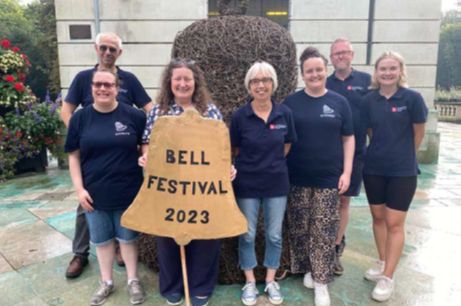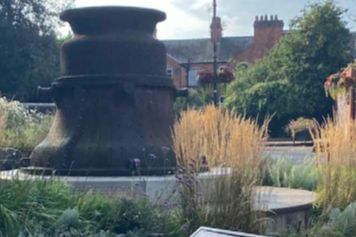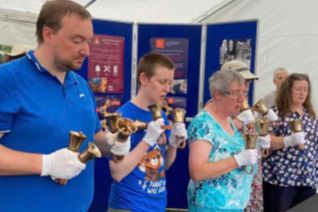Loughborough Bell Festival September 10th 2023
In early 2023, I received a communication from Charnwood Arts who were exploring the idea of organising a festival to commemorate the bell as a unique symbol of Loughborough and its heritage.
They were hoping to hold the event in the summer as part of the National Heritage Open Day initiative and wondered whether I could arrange some bellringing at All Saints’, Loughborough and handbell ringing in Queen’s Park as an important part of the event. They were also keen for the Loughborough Bellfoundry Trust, where I’m a volunteer, to play an important role in the festival. Over the next few months many communications went between relevant parties, plans were developed and Charnwood Arts secured the necessary funding for the project. The first ever Loughborough Bell Festival was given the green light!
Sunday, September 10th started as a bright, sunny day following on from the previous week’s heatwave. When we arrived to ring for morning service, an intricately woven, seven-foot tall wicker bell had already been delivered to the church yard. The wicker bell had been designed and made by local artist Nita Rao, and was intended to represent Great Paul (16.75 tons in E♭) which had been cast in Loughborough in 1881. During the course of the morning, the bell was loaded onto a vintage trailer hitched to a 140-year old steam engine which had arrived from nearby Rempstone. This was intended to emulate the way that Great Paul had been transported from Loughborough to St Paul’s Cathedral.
At 1.30pm crowds gathered in the sunshine and the bell was blessed by the Revd Wendy Dalrymple. The necessary road closures had been put in place and the steam engine set off towards Queen’s Park, with ‘John William Taylor Snr’ (Master Bell Founder from 1858- 1906, responsible for casting Great Paul) and ‘Henry Fearon’ (Rector of Loughborough, 1848-1885, when Great Paul was cast) in period costume leading the way. I understand that one of the Directors of John Taylor’s bellfoundry had been offered the role but had declined! Meanwhile, 19 bellringers had assembled in the tower and were awaiting the signal from the festival organisers to start ringing. Luckily, we had arranged a secret contingency plan in case the festival organisers forgot to give the signal (which they did) and so we started ringing when our church warden, Nicky Morgan, sent a text. Having had recent surgery, I was unable to ring so I organised and conducted the ringing instead! We rang several touches on all 10 bells for around half an hour, with 12 year old Dexter expertly ringing the tenor for rounds and call changes. We received lots of positive feedback about our fabulous sounding bells. Whilst we rang, the wicker bell together with John, Henry, a large entourage of invited dignitaries and members of the public (many of whom were ringing a variety of bells they had brought along with them) paraded through the streets of Loughborough to Queens Park. The journey was much quicker than the 11 days that it had taken to transport Great Paul from Loughborough to London. Unlike the journey in 1881, the party accompanying the bell didn’t try to vandalise it nor inscribe their name on it with chisels and chalk!
The bell was welcomed to the park by the Mayor of Charnwood and a recital on the carillon followed. The bell travelled past the Great Paul bell case, which is exhibited permanently in the park, and was unloaded at the foot of the Loughborough Carillon tower. Loughborough Carillon, standing 152 feet tall, was built as a war memorial for WW1 and it houses 47 bells. Its centenary in July 2023 was marked with an event in the park featuring some specially commissioned carillon music (see RW 5857, p.744). During the afternoon, the Hathern Brass Band played in the band stand, and various groups performed, including Morris dancers and singers. Bell bunting, made at craft workshops ahead of the event, decorated the park. Families had picnics on the grass and there was a long queue for the ice cream van.
The Loughborough Bellfoundry Trust’s stand and gazebo were very popular. Visitors were interested in the historical displays and spent time talking to the Taylor’s representatives. A range of activities, such as moulding bells from magic sand, colouring pictures of bells and ringing coloured handbells, were well received by the children. Once we had finished ringing at Loughborough Parish Church, several of us then had to dash on foot, avoiding the road closures, to Queens Park to give a handbell performance. As we left the church the heavens opened and a rather bedraggled team rushed to the park in good time for the planned performance timeslot. On our way there, the festival organiser rang me to say that they were running ahead of schedule and she wanted us to start ringing handbells straight away. I said that we were on time and couldn’t get there any sooner, so she tried getting the brass band to play something else to fill the gap, but they had disappeared to the refreshment tent, so she struggled to round them up!
We had planned to do our handbell performance from inside the Taylor’s tent, despite the festival organisers wanting to place us in the middle of a large open space. Given the torrential rain, I was really pleased that Chrissie and the museum staff had stuck to their guns and said that we were to be stationed at the front of their stand. We arrived and quickly set up the Taylor demonstration handbells and our music. I gave a short introduction to our first piece and, as we picked up our bells to play, the brass band struck up, very loudly indeed. We put our bells down and waited for them to finish. Meanwhile, our waiting audience – who found the incident amusing – were getting soaked. We successfully delivered a 15-minute programme which the audience enjoyed and they requested an encore which we were happy to play. Our final piece was Psalm 23 – The Vicar of Dibley theme tune, which we dedicated to Charles Bishop. Charles had been a keen member of the handbell band, a much-loved teacher of many ringers and steeple keeper at several local towers. This piece was his favourite and the handbell team plus the bellringing members of the audience were quite emotional as this was played. Charles would have been very amused that, just as we finished playing, the rain stopped and the sun came out. We then had a well-deserved ice cream!
As the festival drew to a close, we all reflected on what a good event it had been. There was even talk of it becoming annual. We also reflected on the hugely successful Heritage Open Day event that we held at the Bell Foundry the previous day, where we had taken about 30 visitors in small groups around the casting hall, which isn’t normally open to the public. Should anyone want to visit Loughborough, there are lots of bell-related things to see and do. The Bell Foundry has an excellent museum, a ring of 12 bells, a carillon (currently undergoing restoration to replace the missing bells) and weekly tours of the works and to see bells being cast. A major, multimillion pound project is well underway to secure and maintain the buildings and to create a new, accessible museum/visitor attraction; this is due to be completed in Summer 2024. All Saints’ church has a fabulous ring of 10 bells (30cwt, practice night Wednesday), an active handbell team and the Taylor memorial chapel at the base of the tower. The wicker bell is now housed in the Old Rectory Museum grounds, next door to the church. In Queen’s Park, there is the huge Great Paul bell case, the Loughborough Carillon (recitals and tower tours are held during the Summer months) and the Charnwood Museum which has displays about the Taylor bell foundry. You would be most welcome to visit us.




